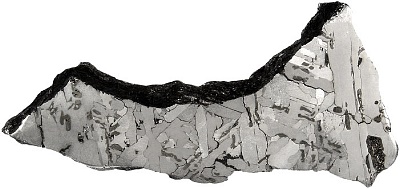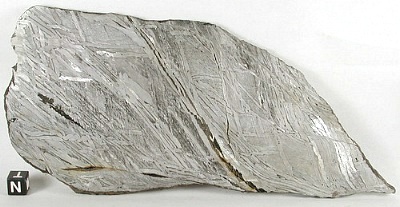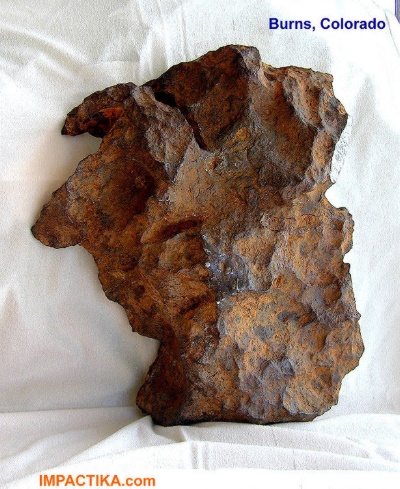IMCA Insights – June 2007
Our Favorite Iron Meteorites, Part 1
by the IMCA Board of Directors
In the previous issues of IMCA Insights 2007 we introduced you to Our Favorite Chondrites and to Our Favorite Achondrites. This overview wouldn't be complete without mentioning Our Favorite Iron Meteorites of the IMCA Board Members, something we would like to start in this issue. As in the past issues you will notice that our preferences are rather distinct, but nonetheless interesting. Enjoy!
Peter Marmet:
In 1984 a farmer from the Twannberg region (near Bern, Switzerland) called Mr. Rolf Buehler (Swiss Meteorite Lab) and told him that he had found a rather weird and very heavy „stone“ in a barley field while ploughing. Mr. Buehler checked the stone and found out that it was an iron meteorite of 15,915 kg. It was classified an ungrouped iron until the year 2000 when Guanaco was found in the Atacama desert in Chile. Guanaco was the fifth member of a compositional grouplet formerly known as the Bellsbank Quartet: Bellsbank, La Primitiva, Tombigbee River and Twannberg. Guanaco provided the missing part to establish a new iron chemical group, and Dr. John T. Wasson proposed, that this new iron group be given the designation IIG.
From the Twannberg I
mass, 29.80g with original NMBE label,
Coll. Peter Marmet
In 2000 Marc Jost was
in the attic of a friend‘s house in Twann. Before he left the attic, he
noticed a strange rusty iron piece of about 2 kilos on top of a wall.
The owner of the house told Marc to keep it. So he kept it for some time
and he even took it with him when he went to the nearby pub for a beer.
Marc showed the iron to his colleagues and told them that he had found a
meteorite and everybody had a good laugh. One day Marc decided to call
the Natural History Museum in Bern (NMBE). Dr. Beda Hofmann, head of the
Earth Sciences Department, answered the phone. Marc Jost told his story
and Dr. Hofmann was quite sure to hear another story of a meteorwrong.
At the end of the short conversation Mr. Hofmann said: By the way, where
are you calling from? Marc answered: From Twann! Mr. Hofmann asked
quickly for Marc‘s address and less than an hour later the doorbell rang
and Mr. Hofmann stood in front of Marc‘s house. Marc‘s iron was indeed
the Twannberg II mass of 2246 grams!
Mass III (2533 g) was identified in September 2005 in a rock and mineral
collection deposited at NMBE as a permanent loan from the Museum Schwab,
Biel, Switzerland, where the sample was originally labelled as
“hematite,” many years ago. Both secondary find places are in the
vicinity (3.5 and 5 km distance) of the original find locality. The
majority of the original mass (10,536 of 15,915 g) and both newly
recovered masses are located at NMBE. The total known mass of Twannberg
now is 20,694 g.
From here it's only a
few hundred meters to the place where the
Twannberg I mass was found
Today, Marc Jost is a passionate meteorite aficionado and the proud owner of a great meteorite collection. He is convinced to find the Twannberg IV mass one day. Good luck, Marc!
Jeff Kuyken:
The Youndegin
iron meteorite was originally discovered during 1884 in the form of four
pieces with weights of 2.7kg, 7.9kg, 10.9kg and 11.7kg. They were found
1.2km Northwest of Penkarring Rock and 112km East of York. In 1891
another mass of 173.5kg, and in 1892 a still larger mass of 927kg were
also found. Another huge meteorite of 2625.3kg was found Southwest of
Quairading, in the vicinity of Wamensking Well, and is now assigned to
this fall. A further mass of about 92kg was located 40km Southeast of
Mount Stirling and is also assigned to this fall. A mass of 1.6kg was
found in about 1893, 97km East of York plus two further masses of 820g
and 742g. These three were referred to the Mooranoppin fall, which is
now considered to be synonymous with Youndegin. It was actually named
Youndegin after a police station which was the last outpost of
civilisation at the time.
Despite the exceptional amount of material discovered, virtually nothing
has ever made it into private collections. Because this meteorite was
discovered a considerable time ago over such a vast area, many of the
pieces were initially named under their own fall. The common synonyms
for Youndegin include Quairading, Penkarring Rock, Mount Stirling and
Mooranoppin. The Total Known Weight of all the Youndegin pieces is in
excess of 3850kg.
Youndegin is an IAB iron meteorite and has been classified twice
somewhat similarly as a Coarse (Og) and Coarsest (Ogg) Octahedrite with
a Nickel content of 6.8%. The main constituent is the nickel alloy
kamacite, in regular well defined plates arranged parallel to the faces
of a regular octahedron. The widths of the plates vary from 1.5mm to 5mm
but the average Widmanstätten Bandwidth has been determined to be
approximately 2.3mm. Simpson (1938) examined Youndegin and observed
Cohenite was “irregularly distributed as rather thick tablets and ragged
grains”. Schreibersite was fairly evenly distributed over the etched
surface as small irregular plates.
A 76.1g Full Slice of Youndegin, IAB Iron Meteorite
This specimen is a 76.1g Complete Slice which has been professionally restored/prepared and is part of the Meteorites Australia Collection (MA.05.0035).
Mark Bostick:
The Seymchan
meteorite was discovered in the Magadan district of Russia during 1967
(62° 54' N., 152° 26' E.) by an expedition of Russian scientists, headed
by E. L. Krinov. A 272.3 kg stone was originally discovered and a 50 kg
stone was found shortly after, but further searching was stopped by snow
as winter started early. Seymchan was classified as a coarse octahedrite
(IIE) iron meteorite and for almost 40 years the classification would go
unchallenged.
During 2004 a new expedition spent several weeks camped in the region
and a number of new Seymchan meteorites were found. Some several kilos,
and others just a few ounces. It was then discovered that the meteorite
was part iron and part stone, a pallasite. Not unlike the Brenham
pallasite, which you can also find in complete iron specimens. Since
these finds Seymchan has been officially reclassified as an ungrouped
iron.
A 520g Full Slice of Seymchan, Mark Bostick Collection
What makes the siderite
specimens of Seymchan so interesting to me is the unusual pattern slices
have. It almost appears as though someone picked up the iron right
before it cooled and twisted it ... several times.
IMCA Director Andrzej S. Pilski compared content of Ni, Ge, Ga, Ir in
Seymchan with data for pallasites and found they match well. "It nicely
resembles pattern of Glorieta. That's why I suspected Seymchan can be
pallasite even before I could see slices with olivine. I did ask Dr.
Wasson and he confirmed, that indeed Seymchan is main group pallasite."
IIE’s often contain numerous inclusions of different iron rich silicates
and Seymchan is full of them. Some slices of Seymchan are so rich with
silicates they remind me of a mesosiderite. Perhaps this is why Seymchan
has been giving an ungrouped iron tag, rather than a pallasite? Whatever
scientists eventually decide Seymchan is, it is one of the more
interesting and best priced meteorites on the market.
Ron Hartman:
Lake Murray
(Coarsest Octahedrite, IIB, TKW: 2401 g) is one of my favorite irons.
Not only because of its unique history, age, and unique structure, but
also because I have had the opportunity to have several slices pass
through my hands, residing either temporarily as semi-permanent members
of my personal collection, or as pieces commissioned from collectors to
my son, Jim, and I, for repair and restoration. The Lake Murrays we have
had were all initially unstable and "rather oozy". Given patience,
though, we were able to "tame" all of them and those that we have kept
tabs on over a period of 6-7 years, including two large slices we now
own, have continued to remain in stable condition, with no
deterioration.
Lake Murray was found in 1933 in Oklahoma, weathering out of Cretaceous
sandstone with a 120 million year terrestrial age, making it the oldest
iron meteorite found on Earth. Several good historical accounts appear
in the literature.
A 2401 gram Lake Murray Iron, R. N. Hartman Collection
Our specimens, including the one you see in the picture here, were deep etched with our modified Ferric Chloride process. Widmanstatten bands are large, and vary considerably in both width and shape. Large troilite nodules, commonly more than an inch across are common and swirls of schreibersite crystals, bordered with bands of kamacite are abundant. Graphite nodules are present, sometimes peppered with tiny specks of metal.
Anne Black:
My favorite iron is Burns. Two to three years ago, I received an email. As in so many other emails, the writer was telling me about a brand-new meteorite. This time the writer was a woman, working for a college in southern Colorado, and the supposed meteorite had been found high in the Rockies. That was unusual enough that I looked at the picture attached to the email.
The New Burns Iron Meteorite in as found condition
The picture was not
encouraging, a large ugly mass on a concrete driveway with a tape
measure. It looked burned, rusty. Probably some slag from some mining
operation. Still, being polite, I pointed her to the website of the
Northern Arizona University and suggested that she wrote to Dr. Ted
Bunch. The picture stayed on my hard-drive, but frankly I forgot all
about it quickly. There were other emails, and other new "discoveries".
Then in early December 2006, I received another email from the same
writer, thanking me for my help, and happy to tell me that it was indeed
a meteorite, a fine octahedrite. I will admit that it took me a while to
figure out who the writer was and what meteorite we were talking about.
Then she informed me that her family had decided to sell the meteorite,
that they would be in Denver in a few days, and could I possibly help
them. Of course, less than 2 weeks later, they were in my living room.
I was glad to meet them and hear all about the circumstances of the
discovery; we agreed on a price quickly and easily and they left me with
a heavy rusty mass wrapped in a pink bath towel. The next day I carried
it, still in the towel to a meeting of the COMETS (COlorado METeorite
Society) where we all examined it, under all angles until someone tried
to stand it on end. And it did stand nicely and then we noticed that
there was almost a face there, in profile. At the end of the meeting,
Fred Hall was kind enough to volunteer to take it home and cleaned it
up.
The Face of "Mr. Burns" - do you see it?
A few days later it was returned to me, still wrapped in its pink towel, but the caliche was gone, it do longer dripped rust and shale. And the face was clearly visible, a long nose, deep-set eye, a curl of hair on a low forehead. It had developed a personality, and acquired a nickname, Mister Burns.
In the August issue of IMCA Insights we will present you with Our Favorite Irons, Part 2 - the July issue is reserved for our special Ensisheim Meteorite Show 2007 Report. Stay tuned, and thanks for your interest!
•
IMCA Home Page •
IMCA Code of Ethics •
IMCA Member List
•
Join IMCA •
IMCA Meteorite Info




